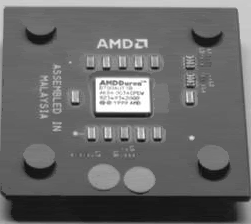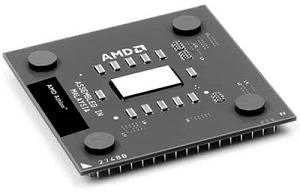AMD Duron, Athlon XP
The AMD Duron processor (originally code named Spitfire) was announced in June 2000 and is a derivative of the AMD Athlon processor in the same fashion as the Celeron is a derivative of the Pentium II and III. Basically, the Duron is an Athlon with less L2 cache; all other capabilities are essentially the same.
It is designed to be a lower-cost version with less cache but only slightly less performance. In keeping with the low-cost theme, Duron contains 64KB on-die L2 cache and is designed for Socket A, a socket version of the Athlon Slot A. Except for the Duron markings, the Duron is almost identical externally to the Socket A versions of the original Athlon.

Essentially, the Duron was designed to compete against the Intel Celeron in the low-cost PC market, just as the Athlon was designed to compete in the higher-end Pentium III market.
The Duron has since been discontinued, but most systems that use the Duron processor can use AMD Athlon or, in some cases Athlon XP, processors as an upgrade.
Because the Duron processor is derived from the Athlon core, it includes the Athlon 200MHz front-side system bus (interface to the chipset) as well as enhanced 3DNow! instructions in Model 3.
Model 7 processors include 3DNow! Professional instructions (which include a full implementation of SSE instructions). Durons that require 1.6V are Model 3 processors, whereas those that require 1.75V are Model 7 processors. The Model 7 version was originally code named Morgan.
AMD Athlon XP
As mentioned earlier, the newest version of the Athlon is called the Athlon XP. This is basically an improved version of the previous Athlon, with improvements in the instruction set so it can execute Intel SSE instructions and a new marketing scheme that directly competes with the Pentium 4.
The latest Athlon XP models have also adopted a larger (512KB) full-speed on-die cache. AMD uses the term "QuantiSpeed" (a marketing term, not a technical term) to refer to the architecture of the Athlon XP. AMD defines this as including the following:
-
A nine-issue superscalar, fully pipelined microarchitecture. This provides more pathways for instructions to be sent into the execution sections of the CPU and includes three floating-point execution units, three integer units, and three address calculation units.
-
A superscalar, fully pipelined floating-point calculation unit. This provides faster operations per clock cycle and cures a long-time deficiency of AMD processors versus Intel processors.
-
A hardware data prefetch. This gathers the data needed from system memory and places it in the processor's Level 1 cache to save time.
-
Improved translation look-aside buffers (TLBs). These enable the storage of data where the processor can access it more quickly without duplication or stalling for lack of fresh information.
These design improvements wring more work out of each clock cycle, enabling a "slower" Athlon XP to beat a "faster" Pentium 4 processor in doing actual work (and play). The first models of the Athlon XP used the Palomino core, which is also shared by the Athlon 4 mobile (laptop) processor.
Later models have used the Thoroughbred core, which was later revised to improve thermal characteristics. The different Thoroughbred cores are sometimes referred to as Thoroughbred-A and Thoroughbred-B. The latest Athlon XP processors use a new core with 512KB on-die full-speed L2 cache known as Barton.
Additional features include
-
3DNow! Professional multimedia instructions (adding compatibility with the 70 additional SSE instructions in the Pentium III but not the 144 additional SSE2 instructions in the Pentium 4)
-
266MHz or 333MHz FSB
-
128KB Level 1 and 256KB or 512KB on-die Level 2 memory caches running at full CPU speed
-
Copper interconnects (instead of aluminum) for more electrical efficiency and less heat
Also new to the Athlon XP is the use of a thinner, lighter organic chip packaging compound similar to that used by recent Intel processors. Figure below shows the latest Athlon XP processors that use the Barton core. This packaging allows for a more efficient layout of electrical components.

The latest versions of the Athlon XP are made using a new 0.13-micron die process that results in a chip with a smaller die that uses less power, generates less heat, and is capable of running faster as compared to the previous models. The newest 0.13-micron versions of the Athlon XP run at actual clock speeds exceeding 2GHz.
Athlon MP
The Athlon MP is AMD's first processor designed for multiprocessor support. Thus, it can be used in servers and workstations that demand multiprocessor support. The Athlon MP comes in the following three versions, which are similar to various Athlon and Athlon XP models:
-
Model 6 (1GHz, 1.2GHz). This model is similar to the Athlon Model 4.
-
Model 6 OPGA (1500+ through 2100+). This model is similar to the Athlon XP Model 6.
-
Model 8 (2000+, 2200+, 2400+, 2600+). This model is similar to the Athlon XP Model 8.
-
Model 10 (2500+, 2800+, 3000+). This model is similar to the Athlon XP Model 8, but with 512KB of L2 cache.
All Athlon MP processors use the same Socket A interface used by later models of the Athlon and all Duron and Athlon XP processors.